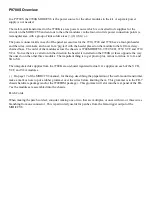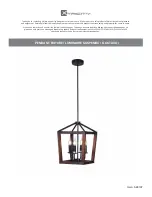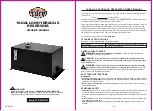
English
English
21/96
If you detect any of the symptoms of the white finger
syndrome, consult immediately with your doctor.
2.3. SECURITY IN THE WORKPLACE
Do not handle the machine in areas that
may have inflamable liquids, gases or dust.
Electrical machines create sparks that could cause
any of these to ignite.
The area included in a 15m radius around
the machine must be considered risk zone
and nobody should be there while the machine is
working and, when necessary, a cord and warning
signals must be used around the working area.
Mantain a minimun clearance of 10m from
current-carrying lines. Life-threatening
danger form electric shock.
Maintain children and passers-by well clear
when working with the machine. Distractions can
cause a lack of control.
When work is to be performed simultaneously by two
or more persons, always check for the presence and
location of others so as maintain a distance between
each person sufficient to ensure safety.
2.4. ELECTRICAL SAFETY
Use only Garland batteries for this machine. Use only
the Garland charger to charge Garland batteries.
Using a different battery or charger may cause battery
explosion and risk of fire.
Be sure to connect the charger to a 230V, 50Hz DC
power supply.
The electrical plug of the charger of this machine
must coincide with the base of the power outlet.
Never modify the plug in any way. Unmodified plugs
and matching bases will reduce the risk of electric
shock.
When using the battery charger, avoid body
contact with grounded surfaces such as pipes,
radiators, electric stoves, and refrigerators. There
is an increased risk of electric shock if your body is
grounded.
Do not expose this machine, charger or
battery to rain or wet conditions. Water
entering them will increase the risk of
electric shock.
Do not abuse the cable. Do not use the cord to carry,
lift, or unplug the charger. Keep cord away from
heat, oil, sharp edges, or moving parts. Damaged or
tangled cords increase the risk of electric shock.
Never use this charger with a damaged cord or plug.
Before connecting the charger check the plug and
cable for damage. If you discover any damage, send
your machine to a technical service for repair. If the
cord is damaged or broken, unplug immediately.
Damaged or tangled cords increase the risk of
electric shock.
The replacement of the plug or power cable must
always be done by the manufacturer or its technical
assistance service. It is recommended to connect
this charger to a residual current device whose
tripping current is less than or equal to 30mA.
Never use a damaged connection base that
does not meet the regulations or the necessary
requirements for this charger.
Disconnect the charger from the mains when not
















































